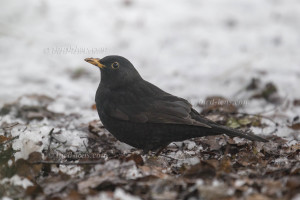 It is cold in Germany. There had been snow the last few nights before. But now it thaws again. The air is cold and clear. The main part in a vast park cemetery is still as packed with a 5 cm thick layer of snow. Only the paths are cleared temporarily by a snow plow. Ok, this is already not a real winter, but there is snow and in between comes out even the sun. Ideal conditions for a walk in the park of the cemetery. On careful examination, there are encountered many blackbirds constantly in the cemetery over the winter. The population of the Eurasian Blackbird (Turdus merula) seem to have increased again now with snow. Everywhere you see a dark bird flit from a side of the road to the other. Under each second (coniferous) trees the ground is intensively scratched. A regularity is not really visible. However, there seems to be a preference for conifers, under which twigs are intensively inverted. A short picking in the substrate and again…..
It is cold in Germany. There had been snow the last few nights before. But now it thaws again. The air is cold and clear. The main part in a vast park cemetery is still as packed with a 5 cm thick layer of snow. Only the paths are cleared temporarily by a snow plow. Ok, this is already not a real winter, but there is snow and in between comes out even the sun. Ideal conditions for a walk in the park of the cemetery. On careful examination, there are encountered many blackbirds constantly in the cemetery over the winter. The population of the Eurasian Blackbird (Turdus merula) seem to have increased again now with snow. Everywhere you see a dark bird flit from a side of the road to the other. Under each second (coniferous) trees the ground is intensively scratched. A regularity is not really visible. However, there seems to be a preference for conifers, under which twigs are intensively inverted. A short picking in the substrate and again…..
A park cemetery, which is not too neat is ideal. Winter food for Blackbirds but also Common Chaffinches (Fringilla coelebs) – besides what lies under leaves and scatter – is offered e.g. by the Barberry. The Barberry (Berberis vulgaris) is a nearly 3 meters tall, colorful shrub with red berries. Especially Common Blackbird and Fieldfare (Turdus pilaris) feed on the red berries in winter. Berries and leaves are hanging on the branches of the barberry until late in the winter.
The individual distance of blackbirds to people is very different. Some are obviously used to the cemetery visitors and allow the approximation to less than 8 meters. Other fly away at the first appearance. When applying patience and maybe crouch against a tree trunk, you can hope that a blackbird while foraging approaches you even closer. The images were made during this occasion.
When feeding, Blackbirds are cautious. In winter, blackbirds must be especially vigilant. Raptors like the Sparrowhawk (Accipiter nisus) and the Northern Goshawk (Accipiter gentilis) are everywhere.
Near the old town of Solingen Graefrath the Gräfrather Park Cemetery is located on a hill. In the second half of the 19th century large cemeteries originated with park-like design. These “park cemeteries” can be derived from an idea from the cemetery of the 19th century in the tradition of peace garden. During the second half of the 19th century, garden green became important components of grave sites. This was Ground Cover and twining plants, flowers and trees were artfully arranged and shaped together with architectural tombs to meet the romantic attitude of that time. Ivy was given a central role in the design and still dominates the appearance of many burial sites. From the perspective of nature conservationists, the cemetery is of great importance in itself. They are a refuges of rare and endangered species. In studies, it was found that wherever older wooded areas and dense thickets are present even forest birds and ground-nesting birds are hosted within the city. Also for the winter, cemeteries with their old stocks and dense woodland thickets offer birds a welcome change in habitat from the cleared agricultural landscape or paved areas in the city.
In the winter time getting some Blackbird in Snow pictures can be seen in the relevant photo forums. Blackbirds, although not a particularly “spectacular” bird, offer a nice photo subject not at least because of the high contrast between dark feathers and white snow. The Blackbird picked extensively the ground under a thin crusted snow layer of birch twigs and threw them to the side. The bird dealt with the twigs and leafs pretty rough and quickly cleared a substantial surface. Before recording the blackbird was obviously hungry and therefore constantly in motion. Fortunately for the photo the Blackbird kept silent for just a moment.
In order to meet the growing demand for top images of the rarer species of Palearctic Bird-lens.com has specifically made trips to remote places in Europe but also to other parts of the world. This to do everything to ensure excellent photos of the Birds of the Western Palearctic . The yield of pictures also of rare Western Palearctic birds is very good. The nice picture of the Eurasian Blackbird of the blog is just a first impressions of what you will find behind the tab “Picture- Store” very soon are. Just give a notice if you need a picture of a bird before the new images are online.